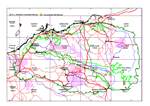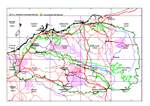Click on images
to enlarge


Typical variant distribution map.

Small pod variant distribution map.

Photographer: B.R. Maslin

Photographer: B.R. Maslin
, AL Payne & PJ Curry 217, lab photo by Fiona McCallum ADJUSTED_sml.jpg)
Seed from one herbarium voucher. Scale in mm. Photographer: F. McCallum.
Botanical name
Acacia sibilans Maslin, Nuytsia 4: 402, figs 11, 12 & 14 (1983)
Common name
Whispering Myall
Description
Attractive trees with a 'Myall'-type growth form, commonly 3-7 m tall but on favourable sites can reach up to 12 m in height and 15 m across, with a single trunk or branching near ground level, trunks often slightly crooked and twisted, crowns dense, silvery grey-green, wide-spreading and concentrated at ends of branches. Bark grey, fibrous, longitudinally fissured except upper branches smooth. Branchlets densely appressed-hairy at apex, becoming glabrous with age. New shoots densely sericeous, the hairs pale yellow at first but soon turning silvery white. Phyllodes filiform, mostly terete, (8-) 10-18 cm long, about 1 mm in diameter, not rigid, ascending to erect, straight to shallowly curved or sinuous, silvery appressed -hairy when young but hairs becoming confined to between the nerves with age; parallel longitudinal nerves numerous, fine; the apex curved to hooked and not spiny. Inflorescences extremely short 2- or 3-headed racemes; peduncles 5-12 mm long, silvery appressed -hairy; heads globular, golden, 26-28-flowered. Flowers 5-merous; sepals free; petals with pale yellow or silvery appressed hairs. Pods pendulous, moniliform, (3-) 7-20 cm long, 7-10 mm wide, ±crustaceous, finely and openly longitudinally reticulate, appressed white-hairy when young but becoming glabrous with age. Seeds longitudinal in the pods, ellipsoid, 9-12 mm long, 5-6 mm wide, not shiny, dark brown; aril small, pale yellow.
Characteristic features
Attractive trees with a 'Myall'-type growth form (trunks slightly crooked and twisted, and crowns dense, silvery grey-green and wide-spreading), producing a soothing hissing sound as wind passes through the foliage. Phyllodes long and slender (mostly 10-18 cm long and about 1 mm), terete, densely silvery appressed -hairy when young. Inflorescences extremely short 2- or 3-headed racemes; peduncles silvery appressed -hairy. Pods large (mostly 7-20 cm long, 7-10 mm wide), moniliform, ±crustaceous. Seeds large (9-12 x 5-6 mm), with a small pale yellow aril.
Distribution and ecology
Confined to northwest Western Australia where the main area of occurrence is the Gascoyne - upper Murchison districts where it extends from the Shark Bay district eastwards to near Mileura Station; there are disjunct occurrences in the Pilbara where it is recorded from Roy Hill and Ethel Creek stations (about 500 km north of Mileura). Around Shark Bay A. sibilans occurs on shallow light brown loam over limestone in low chenopodiaceous shrubland; further inland it is usually found near drainage lines and associated salt flats in Acacia shrubland. The Roy Hill population occurs on rocky red loam in Acacia-dominated open shrubland with A. paraneura (Weeping Mulga), A. xiphophylla (Snakewood) and A. pruinocarpa (Western Gidgee). On Ethel Creek Station it occurs on a flat spinifex plain in red-brown loam over halophytic sub-shrubs and was the only tree present in the area.
Flowering and fruiting period
There are no Pilbara flowering collections of this species. However, over its range it appears to be erratic with respect to flowering (flowers have been recorded for January, April, May and October), and pods with mature seeds have been collected in April, May, October and November. It is possible that flowering follows infrequent heavy rains as has been reported for the related A. papyrocarpa (Boomsma 1981). There is a single Pilbara fruiting specimen with mature seed and this was collected in November.
Variation
A variant with narrower than normal pods (3-5 mm wide) occurs near Giles Point, west of Newman. This variant is seemingly uncommon being otherwise known from a few localities in the Murchison/Ashburton district south of the Pilbara. Further study is needed to ascertain the taxonomic status of this variant.
Affinities
Acacia sibilans has some affinities with A. coriacea and A. sericophylla (both of which occur in the Pilbara) but these species are readily distinguished by their united sepals, large, bright orange seed arils and usually flat and broader phyllodes. It is also related to A. auripila, a rare species that occurs in the Rudall River area east of the Pilbara, and which is distinguished by having narrower and seemingly shorter pods (but few pods seen), heads with 35-40 flowers, and thicker, straighter phyllodes which are generally shorter (8-12 cm long). Also related to A. papyrocarpa (a common species in southern Western Australia and South Australia) which has papery, flat pods with smaller seeds, smaller flower-heads and generally shorter, straighter, sub-terete to flat phyllodes.
Notes
This hardy, attractive, probably long-lived tree has potential for amenity plantings. It is likely, however, to have a relatively slow growth rate.
It has a very dense wood (970 kg/m3), the heartwood is dark brown and the (narrow band of) sapwood is pale-coloured (Thomson and Hall 1989).
Thomson and Hall (1989) suggest that A. sibilans may have potential for soil stabilization on light-textured, calcareous and saline soils, and has some possibilities for providing shade and shelter.
Conservation status
Although this species is uncommon in the Pilbara it is not infrequent in some areas further south and is therefore not considered rare or endangered.
Origin of name
The botanical name is derived from the Latin sibilus (hissing, whistling) and refers to the characteristic (soothing) hissing noise made by the wind blowing through the fine foliage of the canopy (as occurs in species of Sheoak and Pine).
References
Boomsma, C.D. (1981). Native trees of South Australia. Bulletin No. 19. (South Australian Woods and Forests Department: Adelaide.)
Thomson, L.A.J. and Hall, N. (1989). Acacia sibilans. Australian Acacias, Leaflet No. 19. (CSIRO Division of Forests and Forest Products: Canberra.)
